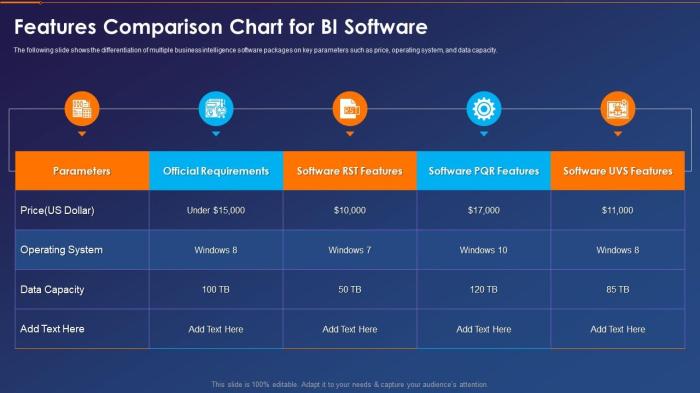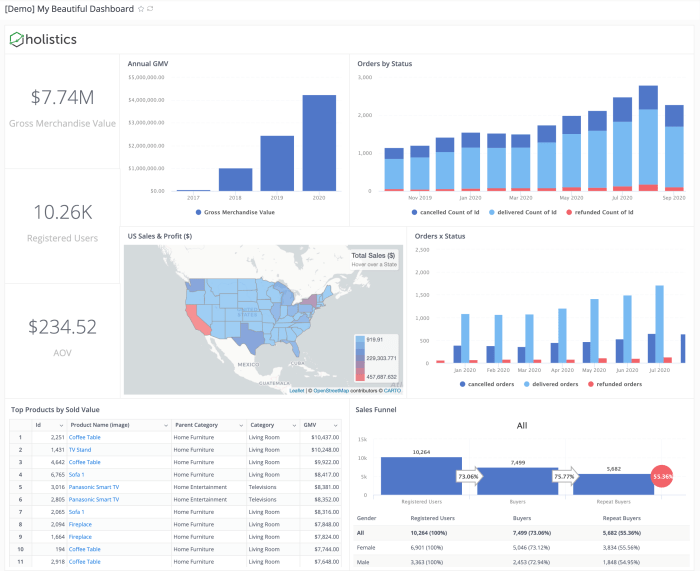BI software comparison sets the stage for a thorough exploration of how these powerful tools can transform data into actionable insights for businesses. In today’s fast-paced digital landscape, selecting the right business intelligence software is critical for enhancing decision-making processes and driving organizational success.
This comparison delves into the essential functionalities and types of BI software, highlighting their significance in modern enterprises. From analytics and reporting to data visualization, understanding the diverse options available can empower businesses to leverage their data effectively.
Overview of BI Software: BI Software Comparison
Business Intelligence (BI) software is a technology that helps organizations collect, process, and analyze data to make informed decisions. In an era where data drives business strategies, the importance of BI software cannot be overstated; it enables companies to harness data for competitive advantage. Companies can transform raw data into actionable insights, allowing for enhanced decision-making and strategic planning.
Typically, BI software encompasses a range of features and functionalities, such as data visualization, reporting tools, dashboards, and data mining capabilities. These tools allow users to visualize data trends, generate reports, and create interactive dashboards that facilitate data exploration. BI tools can be categorized into several types, including traditional BI platforms, cloud-based solutions, and self-service BI tools, each catering to different organizational needs.
Criteria for BI Software Comparison

Choosing the right BI software requires careful consideration of several key criteria. Important factors to evaluate include:
- Ease of Use: The user interface should be intuitive and user-friendly, allowing users to navigate without extensive training.
- Integration Capabilities: The software should seamlessly integrate with existing systems and data sources, ensuring smooth data flow and accessibility.
- Pricing Models: Understanding the cost structure is crucial; businesses should evaluate whether the software uses a subscription model, one-time licensing, or tiered pricing based on features.
Furthermore, when comparing cloud-based and on-premise BI solutions, organizations should consider functionality, scalability, and maintenance costs. Cloud-based solutions offer flexibility and lower upfront costs but may require ongoing subscription fees, while on-premise solutions may demand higher initial investments but provide greater control over data security and customization.
Popular BI Software Solutions
Several leading BI software solutions dominate the market, each with unique features tailored for different user needs. Notable BI tools include Tableau, Power BI, and Qlik, which are recognized for their robust functionalities.
| BI Tool | Key Features | Strengths | Weaknesses |
|---|---|---|---|
| Tableau | Advanced visualizations, drag-and-drop interface | Highly interactive dashboards | Can be costly for larger teams |
| Power BI | Integration with Microsoft products, customizable reports | Cost-effective for organizations using Microsoft services | Limited capabilities on the free version |
| Qlik | Associative data indexing, real-time analytics | Strong data integration and visualization | Steeper learning curve than competitors |
Each of these tools has its strengths and weaknesses, making it essential for businesses to consider their specific needs when selecting a BI solution.
Use Cases for BI Software
Various industries leverage BI software to enhance operational efficiency and decision-making. Examples of use cases include:
- Sales Performance Tracking: Organizations use BI tools to analyze sales data, track performance metrics, and identify trends to inform sales strategies.
- Customer Analytics: Companies utilize BI software to gain insights into customer behavior, preferences, and demographics, enabling personalized marketing efforts.
- Operational Efficiency: BI tools can pinpoint inefficiencies in operations, helping organizations optimize processes and reduce costs.
BI software plays a critical role in data-driven decision-making, enabling companies to act on insights derived from their data.
Implementation and Integration of BI Software

Implementing a BI tool in a business environment involves several key steps:
- Assessment of Needs: Identify specific business requirements and goals that the BI tool should address.
- Selection of Tools: Evaluate and select the appropriate BI software that aligns with organizational needs.
- Data Preparation: Ensure that data is clean, structured, and ready for integration into the BI system.
- Training and Deployment: Provide training for users and deploy the software in a phased manner to ensure a smooth transition.
Integrating BI software with existing systems is crucial for maximizing its effectiveness. Best practices include ensuring data compatibility, providing robust documentation, and facilitating ongoing support. Common challenges faced during implementation include data silos and resistance to change, both of which can be mitigated through comprehensive training and clear communication.
Future Trends in BI Software, BI software comparison
Emerging trends and technologies are continuously reshaping the landscape of BI software. Key trends include:
- Artificial Intelligence and Machine Learning: These technologies enhance data processing capabilities, allowing for more sophisticated analytics and predictive modeling.
- User Experience Focus: As BI tools evolve, there is a growing emphasis on improving user experience through intuitive interfaces and streamlined workflows.
- Data Visualization Evolutions: Advances in data visualization techniques will enable users to derive insights more efficiently through dynamic and interactive representations of data.
These developments will significantly impact how organizations leverage BI tools for strategic decision-making.
Cost Analysis of BI Software

A comprehensive cost analysis of BI software is essential for organizations to understand the financial implications of their investment. Pricing models can vary significantly, so it is crucial to compare options effectively.
| BI Tool | Pricing Model | Total Cost Considerations |
|---|---|---|
| Tableau | Subscription-based, tiered pricing | License fees, implementation costs, training |
| Power BI | Monthly subscription, free tier available | Potential hidden costs for additional features |
| Qlik | Annual licensing | Training and customization expenses |
Organizations should also evaluate the total cost of ownership, which includes licensing, training, and ongoing support. Understanding the return on investment (ROI) and financial benefits associated with BI solutions is critical for justifying the expenditure.
User Experience and Community Support
User experience is a vital criterion when selecting BI software, as it directly impacts user adoption and overall effectiveness. A positive user experience can lead to higher productivity and better engagement with the tool.
Community support resources play an essential role in assisting users. Many BI tools have thriving online communities, forums, and user groups where users share knowledge, tips, and best practices.
The impact of customer feedback is significant, as it often drives software updates and enhancements, ensuring that the tool evolves to meet user needs and industry standards.
Conclusion
In summary, the landscape of BI software is rich and varied, offering numerous solutions tailored to different business needs. By evaluating the strengths and weaknesses of popular BI tools and considering future trends, organizations can make informed choices that enhance their data-driven strategies. Investing in the right BI software not only streamlines operations but also fosters a culture of innovation and growth.